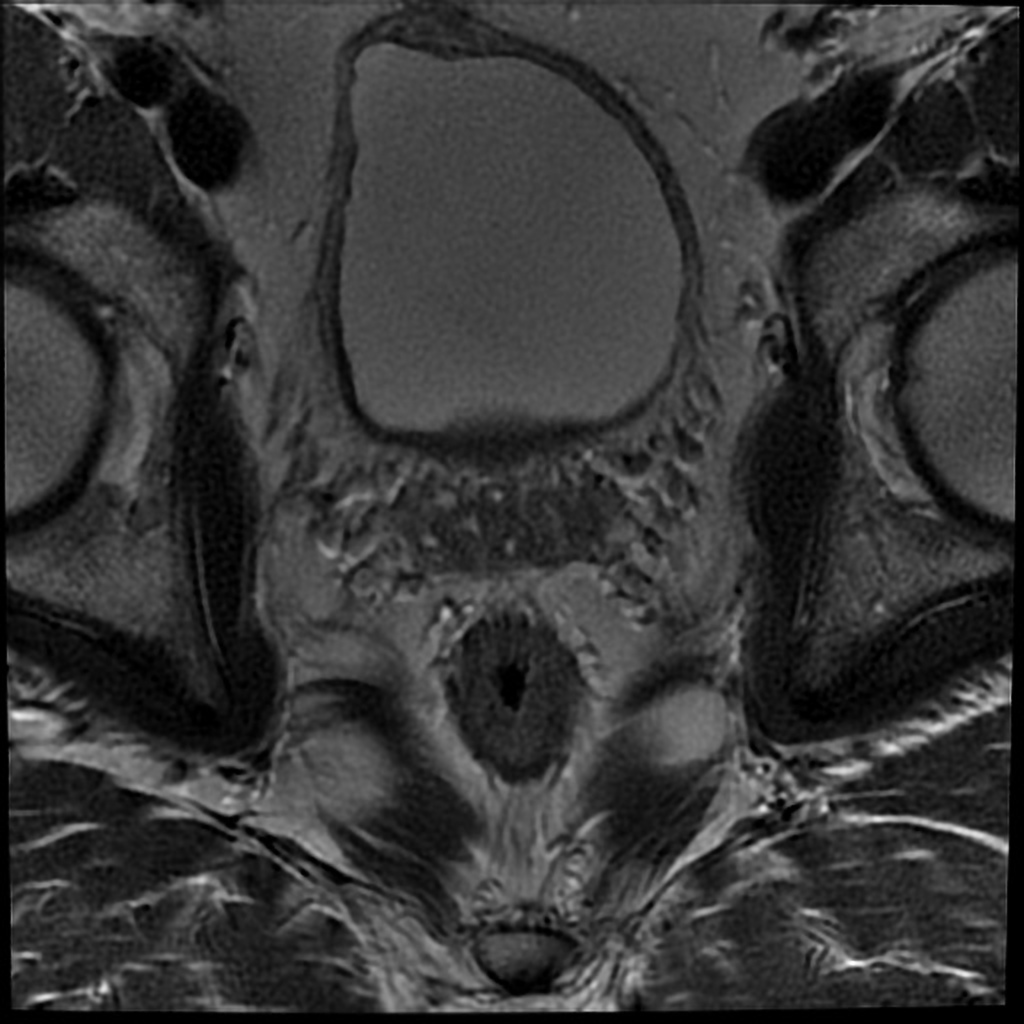Prostatitis MRI
|
Prostatitis Microchapters |
|
Diagnosis |
|
Treatment |
|
Case Studies |
|
Prostatitis MRI On the Web |
|
American Roentgen Ray Society Images of Prostatitis MRI |
Editor-In-Chief: C. Michael Gibson, M.S., M.D. [1] Associate Editor(s)-in-Chief: Maliha Shakil, M.D. [2], Usama Talib, BSc, MD [3]
Overview
MRI can be used to diagnose prostatitis. Though it is not used commonly, its utilisation when suspecting alternate diagnosis like prostatic abscess or prostatic carcinoma etc is very important. An abscess may be suspected in patient with prostatitis if the fever fails to resolve after 36 hours of therapy and needs further workup with an MRI being a possible investigation. MRI in case of a patient wit prostatitis depicts diffuse enlargement of the gland.[1][2][3]
MRI
MRI depicts diffuse enlargement of the gland. Inflammatory changes of the fat around the prostate and the seminal vesicles. It has been shown that combining the morphology with the conventional MRI investigation can be more effective in differentiating prostatitis from early peripheral prostatic cancer.[1][4][5][6]
Findings of acute prostatitis on MRI include:
- T1: peripheral zone which is similar or less intense than the transitional zone
- T2: hyperintense
- Gd (C+): diffusely enhancing
Prostate Imaging Reporting and Data System
Prostate imaging reporting and data system or PIRADS score is very helpful in diagnosing prostatitis and differentiating it from prostatic cancer.[7][8]
- A higher PIRADS score can differentiate prostatic inflammation from carcinoma more reliably.
- Decreased diffusion favours the diagnosis of prostatitis.
Image
Given below is a representation of the granulomatous prostatitis diagnosed with the help of an MRI.

References
- ↑ 1.0 1.1 Prostatitis. Radiopaedia 2016. http://radiopaedia.org/articles/prostatitis. Accessed on Feb 09, 2017
- ↑ Sharp VJ, Takacs EB, Powell CR (2010). "Prostatitis: diagnosis and treatment". Am Fam Physician. 82 (4): 397–406. PMID 20704171.
- ↑ Choon-Young Kim, Sang-Woo Lee, Seock Hwan Choi, Seung Hyun Son, Ji-Hoon Jung, Chang-Hee Lee, Shin Young Jeong, Byeong-Cheol Ahn & Jaetae Lee (2016). "Granulomatous Prostatitis After Intravesical Bacillus Calmette-Guerin Instillation Therapy: A Potential Cause of Incidental F-18 FDG Uptake in the Prostate Gland on F-18 FDG PET/CT in Patients with Bladder Cancer". Nuclear medicine and molecular imaging. 50 (1): 31–37. doi:10.1007/s13139-015-0364-y. PMID 26941857. Unknown parameter
|month=ignored (help) - ↑ Rajeev Jyoti, Noel Hamesh Jina & Hodo Z. Haxhimolla (2016). "In-gantry MRI guided prostate biopsy diagnosis of prostatitis and its relationship with PIRADS V.2 based score". Journal of medical imaging and radiation oncology. doi:10.1111/1754-9485.12555. PMID 27987276. Unknown parameter
|month=ignored (help) - ↑ P. Li, Y. Huang, Y. Li, L. Cai, G. H. Ji, Y. Zheng & Z. Q. Chen (2016). "[Application evaluation of multi-parametric MRI in the diagnosis and differential diagnosis of early prostate cancer and prostatitis]". Zhonghua yi xue za zhi. 96 (37): 2973–2977. PMID 27760657. Unknown parameter
|month=ignored (help) - ↑ J. Curtis Nickel (2003). "Recommendations for the evaluation of patients with prostatitis". World journal of urology. 21 (2): 75–81. doi:10.1007/s00345-003-0328-1. PMID 12684835. Unknown parameter
|month=ignored (help) - ↑ Rajeev Jyoti, Noel Hamesh Jina & Hodo Z. Haxhimolla (2016). "In-gantry MRI guided prostate biopsy diagnosis of prostatitis and its relationship with PIRADS V.2 based score". Journal of medical imaging and radiation oncology. doi:10.1111/1754-9485.12555. PMID 27987276. Unknown parameter
|month=ignored (help) - ↑ Michael Meier-Schroers, Guido Kukuk, Karsten Wolter, Georges Decker, Stefan Fischer, Christian Marx, Frank Traeber, Alois Martin Sprinkart, Wolfgang Block, Hans Heinz Schild & Winfried Willinek (2016). "Differentiation of prostatitis and prostate cancer using the Prostate Imaging-Reporting and Data System (PI-RADS)". European journal of radiology. 85 (7): 1304–1311. doi:10.1016/j.ejrad.2016.04.014. PMID 27235878. Unknown parameter
|month=ignored (help) - ↑ Libre Pathology https://radiopaedia.org/cases/granulomatous-prostatitis-1 Accessed on Feb 13, 2017